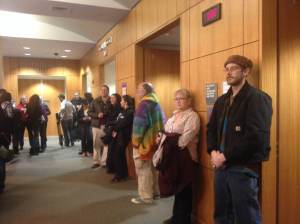October 14, 2015
 The seventh day of testimony in the Fairbanks Four proceedings featured the completion of the trooper testimony and several witnesses who also testified in the original trials. The Fairbanks Four were represented by the Alaska Innocence Project, Office of Public Advocacy attorney Whitney Glover, and the renowned international firm Dorsey and Whitney, who have acted with amazing generosity and dedication in their pro bono representation of George Frese. As this case unfolds it is important for readers to understand that an eighteen year old wrongful conviction case with no DNA and heavy political opposition is about as close to mission impossible in the legal world as an attorney can get, and every day of testimony demonstrates a level of quality and dedication in the work of these attorneys that deserves admiration. Because of this work, as in previous days, the proceedings heavily favored the alternate suspect theory and bolstered the evidence for the innocence of the Fairbanks Four.
The seventh day of testimony in the Fairbanks Four proceedings featured the completion of the trooper testimony and several witnesses who also testified in the original trials. The Fairbanks Four were represented by the Alaska Innocence Project, Office of Public Advocacy attorney Whitney Glover, and the renowned international firm Dorsey and Whitney, who have acted with amazing generosity and dedication in their pro bono representation of George Frese. As this case unfolds it is important for readers to understand that an eighteen year old wrongful conviction case with no DNA and heavy political opposition is about as close to mission impossible in the legal world as an attorney can get, and every day of testimony demonstrates a level of quality and dedication in the work of these attorneys that deserves admiration. Because of this work, as in previous days, the proceedings heavily favored the alternate suspect theory and bolstered the evidence for the innocence of the Fairbanks Four.

Well known celebrity as they would be seen from 550ft. Want to see the original? click HERE
Dr. Geoffrey Loftus, a University of Washington psychology professor, testified in the 1999 trial of Eugene Vent. During that trial he testified that a typical person would not be able to make an eyewitness identification from 500 feet away, as Arlo Olson claimed he had in his original trial testimony. Olson has since recanted multiple times and testified during these proceedings that his fabricated testimony was the brainchild of Officer Aaron Ring and Prosecutor Jeff O’Bryant, memorized by Olson at their request, and given under pressure and threats. In the Vent trial, Olson’s testimony trumped Loftus’, and Vent was convicted. In 1999, Loftus testified based on what he called “common sense,” but his testimony did not result in a not guilty verdict. This loss inspired Loftus to conduct more detailed research into visual perception in relation to distance, and he returned to court these many years later with significant peer-reviewed studies and empirical evidence that confirmed what in the original trials many, including Loftus, believed common sense should have confirmed on its own in 1999. Loftus is now responsible for the leading research in the world into the way factors like distance and light impact visual perception. In short, Loftus did millions of dollars worth of research into the concept that has long brought the Olson testimony into questions – how far can the human eye see well enough to identify someone? Loftus’ findings confirmed that a person with normal vision could not identify anyone from 550 feet away, and likewise could not do so in the dark.
Loftus, who has testified at nearly 300 criminal trials, endured hours of disjointed questioning under cross-examination. The premise of cross-examination carried out by Bob Linton on behalf of the state was difficult to find a thread or strategy in but in that it had a theme was twofold – the state argued that it may be possible to identify someone without seeing their face, and that Loftus was biased, or at least not considering elements of the case not related to eyesight. Given that Loftus is specifically an expert on the limitations of human sight and any other elements of the case are not related to his testimony, he understandably was only familiar with eyewitness portions of the case, but the State asked about his familiarity with much of the original trials. Loftus indicated over and over that he was not familiar with the rest of the case, and was there to testify about the abilities Loftus had focused too much of his research and testimony on the face, and that it may be possible to identify someone from that distance because of recognizing body characteristics. Loftus countered that factors like arm length or build are not sufficient for identifying an individual. The state also argued that Loftus did not have testimony specific to Olson – Loftus acknowledged that his research and testimony focus on the human eye, and that he did not know if Arlo Olson had unusually good eyesight.
Two notable alibis also returned to the stand. Joey Shank confirmed the testimony he gave during the original trials. Shank was the driver of the car that drove Eugene Vent and Kevin Pease from a house party across to downtown Fairbanks and appears on Vent and Pease’s timelines. Shank was sober in the night in question and long before police had determined a time of death for Hartman provided a solid alibi for Pease and Vent from late evening to after 2:00 am. These many years later he affirmed is certainty on the time and that he was with both Pease and Vent across town when Hartman was killed.
Frank Dayton, who was assaulted the same night Hartman was killed, and whose assault Olson claimed to have seen from some 550 feet away testified that he was unable to see his attackers. His testimony reaffirms his account, as summarized in an earlier blog post.
The state objected to the admission of witnesses who had appeared at the original trials. Generally, the State of Alaska has largely objected on procedural grounds to the admission of evidence, experts, witnesses, and information in general on the case. The state made clear in opening arguments that they did not even want the hearing happening now to proceed, despite their original position that they were in favor of the hearing, because although they were certain the convictions were just fine felt the community needed closure.
In the end, four witnesses took the stand on the seventh day of litigation. Trooper McPherron completed his testimony. McPherron was one of the two cold case troopers who worked under Bachman in the case and ultimately came to court to verify that she hid information from them, instructed them not to collect exonerating evidence, and terminated the investigation before its end, apparently displeased that their investigation turned up information indicating the four are innocent and the alternative suspects are guilty. Joey Shank confirmed that he was with Pease and Vent across town when Hartman was killed. Frank Dayton reaffirmed his testimony. Eyewitness expert Loftus confirmed that the Olson testimony was a fabrication.
Sometime during all of this testimony, less than a mile away from the courthouse, supporters of the Fairbanks Four held a fundraiser and raised $17,000 for the Alaska Innocence Project selling Indian Tacos. Every time the State of Alaska makes it clear that they simply do not feel like dealing with wrongful conviction, the truly amazing people of Alaska appear in droves to make sure they will have to face the innocent now and in the future. If you would like to join them in their beautiful and humbling efforts you can donate here online or here. Or, light a candle, take a walk, appreciate things, think good thoughts, do something nice for someone else, keep an open mind, question the powers that be, vote, kiss a baby, adopt a dog, visit someone lonely, smile, remember someone who felt forgotten – we will gladly accept any of these in-kind donations because we depend on people who let the darker parts of life remind you to shed some light in this world.

























 The Alaska Innocence Project lead counsel Bill Oberly and attorney Colleen Libbey filed silmoutaneous motions in Fairbanks Superior Court accusing the State of Alaska of accomplishing little more than “wasting paper” in their
The Alaska Innocence Project lead counsel Bill Oberly and attorney Colleen Libbey filed silmoutaneous motions in Fairbanks Superior Court accusing the State of Alaska of accomplishing little more than “wasting paper” in their 



